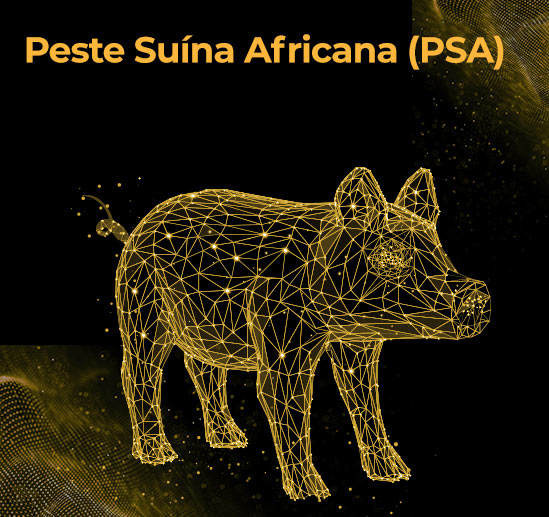the role of immunity and empowerment
Furthermore, it is important that pig farmers and agribusinesses intensify biosafety procedures throughout the production chain.
Verônica Lisboa, a Yes specialist, talks about the dangers of the disease for Brazilian herds and how immunomodulation can help prevent the disease

In July, the International Organization for Animal Health received a notification of a case of African Swine Fever (PSA) in the Dominican Republic, a country in Central America. Brazil has been considered free of the disease since 1984, but the news worries the Brazilian swine industry and lights up the warning sign.
This is because PSA poses no risk to humans, but is highly deadly to pigs, it is a highly contagious disease that has no cure or treatment. In 2018, an outbreak of African swine fever in China decimated half of the country's swine herd, the world's largest, throwing the global meat market out of balance. China is still looking to rebuild its squad. Since early 2021, a total of 11 PSA outbreaks have been officially reported in China, involving eight provinces with 2,216 animals euthanized.
"The Ministry of Agriculture, Livestock and Supply (MAPA), has been acting very quickly, disclosing assertive measures regarding inspections in ports, airports, restrictions on the entry of visitors to farms and the proper thermal treatment of food waste from aircraft and ships coming from abroad”, points out Verônica Lisboa, Technical and Research Coordinator at YesSinergy®. "It is also important that pig farmers and agribusinesses intensify biosafety procedures throughout the production chain."
A disease with high mortality rates
Once contaminated, the pig presents some easily observed clinical signs: such as fever (above 42 degrees), diarrhea with the presence of blood, joint edema, skin necrosis, hemorrhage, redness at the tip of the ear, tail, abdomen, in distal limbs, vomiting and miscarriages. “Often, between 24 and 48 hours before death, these animals show very great lack of motor coordination, lack of appetite and apathy”, he points out.
Another factor to be considered among preventive measures that can help keep the swine herd strengthened is the maintenance of the animal defense system strengthened, that is, prepared to respond to the most varied challenges encountered by animal production, including viral diseases .
In a recent publication, Franzoni et al, 2021, point out that given the relevance of PSA infection, a deeper understanding of the immune responses of pigs against the virus should be better understood and addressed.
To understand the importance of the defense system against PSA, we must understand how the swine's immune system reacts to the virus:
The swine defense system & the PSA
The PSA virus predominantly infects monocytes and macrophages (Sánchez et al., 2012) which are cells that play a critical role in the immune system, as they can initiate the immune response by secreting interleukins and carrying out the elimination of pathogens through of phagocytosis (Reis et al 2017).
After infection, the virus induces apoptosis (cell death) of lymphocytes, whether infected or not (Ibanez et al, 1996), triggering a picture of lymphopenia, also marked in the pathogenesis of PSA.
Several scientific studies (Teijaro et al, 2017; Basler et al, 2017; Zhu et al, 2019; Wang et al, 2020) report the pathogenesis of the virus linked to the high production of pro-inflammatory interleukins, produced by infected monocytes and macrophages constituting the event called “cytokine storm”, which researchers consider to be the heart of the disease and the initial cause of high mortality.
Cytokine storm can be defined as a physiological reaction in which the innate immune system causes an uncontrolled and excessive release of pro-inflammatory cytokines (Fig 1).

In PSA, monocytes and macrophages are primarily responsible for the interleukin storm (Fig 2).

In a recent study by Zhu et al, 2019, when analyzing interleukins produced by porcine macrophages (ex vivo) infected by PSA, the authors observed that TNF family cytokines may play an important role in the pathology of the disease, reporting the observation of significantly high expression of seven pro-inflammatory cytokines TNF (FASLG, LTA, LTB, TNFSF4, TNFSF10, TNFSF13B and TNFSF18), hours after infection.
Importantly, these cytokines not only induce cell death/apoptosis, but also cause tissue inflammation (Croft et al, 2017), as well as the interleukins FASLG and TNFSF10 can trigger apoptosis in CD4 cells+ and CD8+ (Roe et al, 2004), which could explain lymphopenia during PSA infection. Furthermore, up-regulation of the pro-inflammatory interleukin IL17A was observed after only 09 hours of infection.
In contrast, the authors reported a drop in the production of the anti-inflammatory interleukins IL10 and IL10RA and postulated that the PSA virus expresses several proteins that inhibit the signaling pathways for the production of these interleukins.
The down-regulation of expression of anti-inflammatory markers coincided with the significant increase in viral genes.
Recent studies have postulated that IL-10 may play a key role in the strategy to combat PSA (Sánchez-Cordón, 2020). Previous trials of experimental vaccines have also suggested that IL-10 may help control early stages of viral replication and mitigate the harmful costs of an intensified inflammatory response that characterizes acute PSA infections (Sánchez-Cordón, 2018).
Wang et al, 2021 evaluated the parameters of immunity of pigs infected with PSA. According to the authors, the animals developed severe clinical symptoms three days after virus inoculation and died 7 to 8 days later.
Serum analysis revealed a trend towards robust and sustained elevation of pro-inflammatory interleukins: TNF-a, IFN-a, IL-1b, IL-6, IL-8, IL-12 and IL-18. The increase in IL-10 was only observed in the terminal phase of the infection. This secretion pattern corresponds to the aforementioned typical cytokine storm, characterized by the unregulated onset of pro-inflammatory IL's secretion and an unbalanced anti-inflammatory response.
The Role of CD8 Cells+
Cytotoxic T cells play an important role in protecting against intracellular antigens (Franzoni et al, 2021) and especially CD8α T cells+, play an important role in protective immunity against PSA (Oura et al., 2005).
After exposure to a low virulence PSA strain the pigs had their CD8α lymphocyte count+ drastically decreased. A subsequent challenge with a homologous but virulent strain revealed that the depleted animals had the drop in CD8α lymphocytes+ suffered from severe acute PSA and died, while animals that had normal values of CD8α+ they presented only mild clinical symptoms and survived (Montoya et al, 2021).
An early reference to TCD8 effector cells+ specific for PSA is reported by Norley and Wardley (1984): the authors infected pigs with a virulent Ugandan isolate and examined the peripheral blood mononuclear cells (PBMCs) from these animals. The effector cells were able to specifically attack PSA-infected cells. Since unsorted PBMCs were used, it was assumed that CD8 cells+ were involved in cytotoxicity.
Use of immunomodulators in animal production
According to Blecha, F. (2001), the objective of immunomodulation in production animals is to balance the immune response for the benefit of the animal and the efficiency of production. Immunomodulators are substances that act on this mechanism.
Although the treatment and prevention of infectious diseases are the most common reasons for the use of immunomodulators, other conditions such as improved stress-induced immunosuppression, maturation of the newborn's developing immune response, and strategies to reduce the metabolic cost of triggering an immune response are also well suited for its use.
Continued discovery of new immune regulators and increased understanding of immunity in farm animals will secure new opportunities for the use of these additives (Dhama et al, 2015).
GLUCANGOLD
THE YesSinergy® presents in its portfolio a potent immunomodulator: GLUCANGOLD. Source of purified and concentrated 1,3 and 1,6 β-glucans from the yeast cell wall Saccharomyces cerevisiae, O GLUCANGOLD it's an additive Natural with proven properties IMMUNOMODULATORY.
Scientific research attests to the IMMUMOMODULATOR effect of GLUCANGOLD
In a research carried out at USP, Ribeirão Preto, Brazil, with the objective of evaluating the immunological response of macrophages induced by LPS, the GLUCANGOLD showed an immunomodulatory effect by increasing the production of IL-10 and decreasing the production of pro-inflammatory interleukins in a situation prior to the challenge, that is, without triggering an exacerbated immune response and preparing the animals to respond more effectively to possible challenges.
When evaluated in a challenge situation already installed, the GLUCANGOLD increased IL-6, which is necessary in situations of illness, aiming to signal to the body the need to recruit immune cells so that the defense process against the invading agent can begin, however, it did not alter the production of TNF-α o that prevents an exacerbated and unbalanced inflammatory response, and, more importantly, induced an increase in IL-10, important for controlling the inflammatory response.
In a study conducted at the Universidad Austral de Chile, in order to evaluate the effects on the expression of immune markers in shk-1 cells from Salar o Salmon GLUCANGOLD provided a balanced response of pro and anti-inflammatory markers, highlighting, once again, the increase in the production of IL-10.
In a research carried out at the Federal University of Grande Dourados, Faculty of Health Sciences, with the objective of evaluating the effect of GLUCANGOLD as an immunomodulator against a low challenge with Salmonella enterica in guinea pigs. In this research the predictive model for pigs was adopted.
Again, the immunomodulatory effect of GLUCANGOLD it was proven by observing a decrease in interleukins TNF - α and an increase in the expression of interleukin IL-10, in addition to the control of Salmonella.
At UNESP, Dracena campus, São Paulo, Brazil, the GLUCANGOLD was added to the diet of laying hens in order to verify its effect on the animals' immune parameters. Birds that received the immunomodulator in the diet had monocytes and heterophylls with significantly higher phagocytic intensity, in addition to a higher ratio of CD4 cells+:CD8+, when compared to the group of animals that did not receive the additive in the diet.
The study of immunomodulation has the potential to produce fundamental insights into the regulation of inflammation and how cells respond to aggression (Barrado – Gil, 2021).
Thus, it is believed that the introduction of GLUCANGOLD to the animals' diet may provide another pattern of cellular immunity response, reducing the effects of aggression, immunomodulating the swine's defense system and making them better prepared for the main challenges, including viral ones, such as PSA.
It is noteworthy that there is no vaccine for PSA, but due to the high virulence and contagion presented by the disease, all measures that can act to strengthen the animals and prevent the virus from entering the herds is of great value to the production chain.
We are passionate about science!
Founded in 2008, the YesSinergy® it combines animal welfare, food safety and sustainability to produce natural additives that replace antibiotics for animal health and nutrition. Since 2016, YES has been part of Aqua Capital, an investment fund aimed at companies in the agribusiness sector in Brazil and South America.
